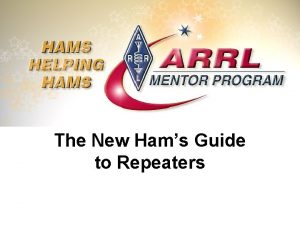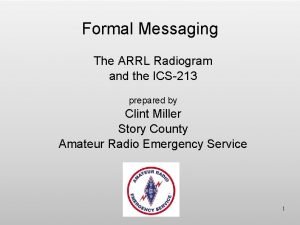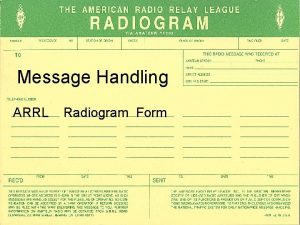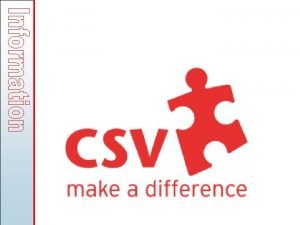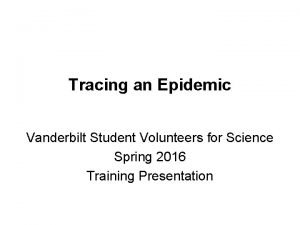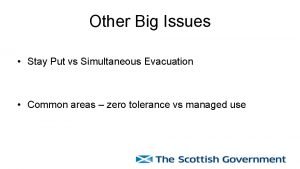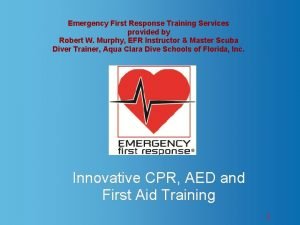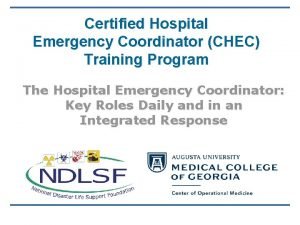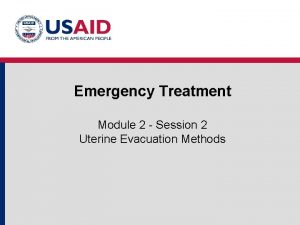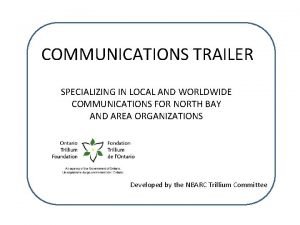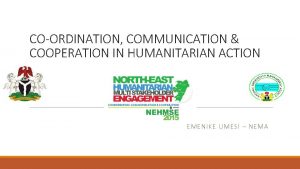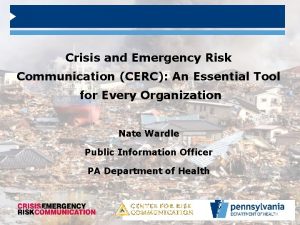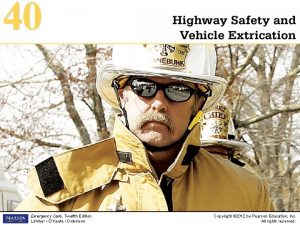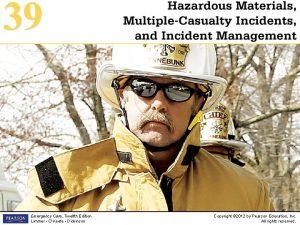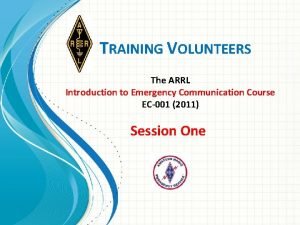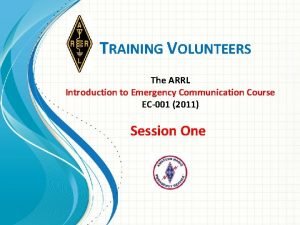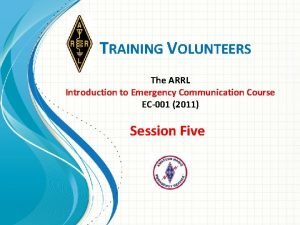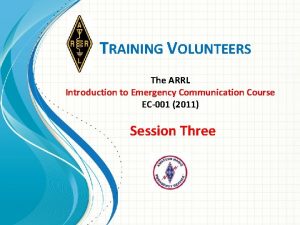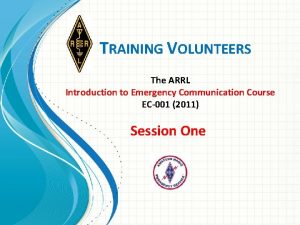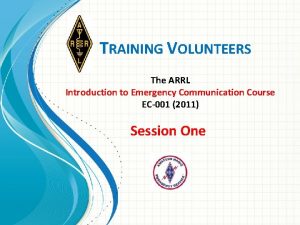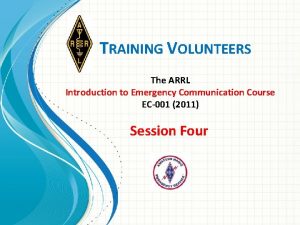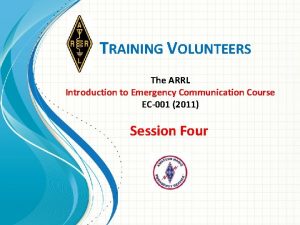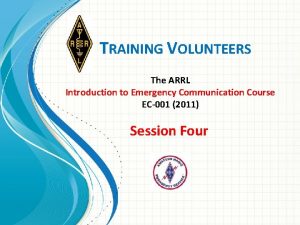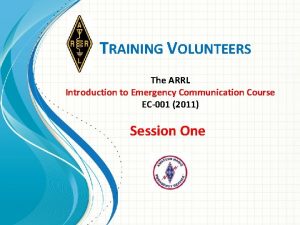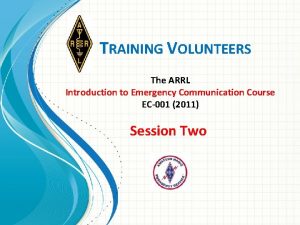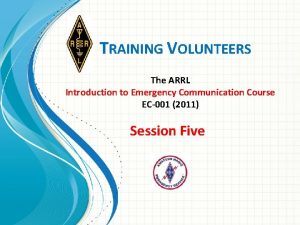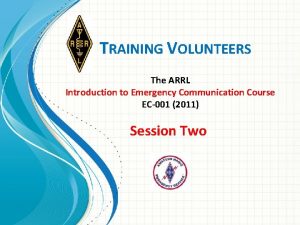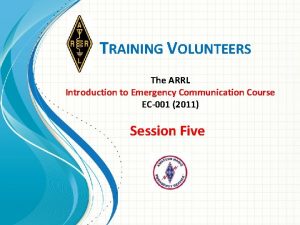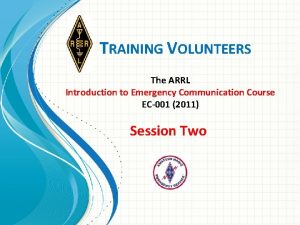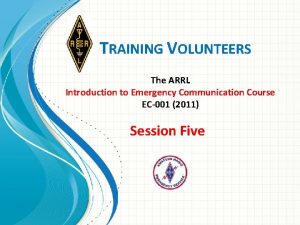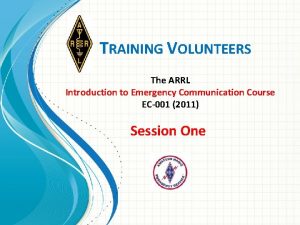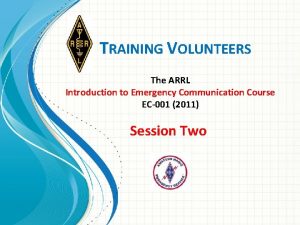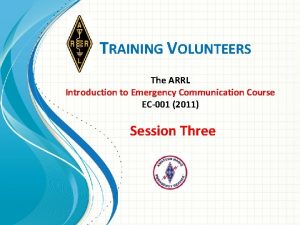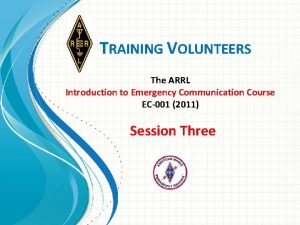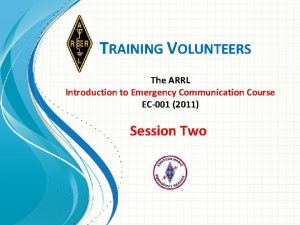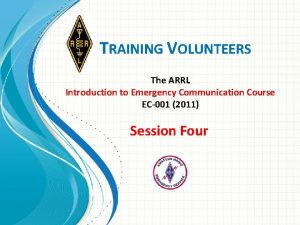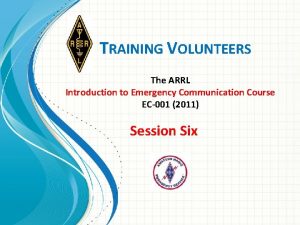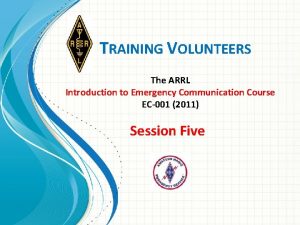TRAINING VOLUNTEERS The ARRL Introduction to Emergency Communication





























- Slides: 29

TRAINING VOLUNTEERS The ARRL Introduction to Emergency Communication Course EC-001 (2011) Session Four

Reminder • Complete two DHS/FEMA Courses • IS-100. b Introduction to ICS • IS-700 National Incident Management System Http: //training. fema. gov/IS/NIMS. asp

Session Four Topic Session 1 – Topics 1, 2, 3, 4, 5 a, 5 b Session 2 – Topics 6, 7 a, 7 b, 7 c, 7 d, 8, 9, 10 Session 3 – Topics 11, 12, 13, 14, 15 Session 4 – Topics 16, 17, 18, 19, 20 Session 5 – Topics 21, 22, 23, 24, 25, 26, 27 Session 6 – Topics 28, 29, Summary, Final Exam

Topic 17 – Preparing for Deployment

Prepared for What? • You never know which challenges an emergency situation will offer • Wide range of considerations – including radio equipment – power sources – clothing and personal gear – food and water, – information – specialized training

Prepared for What? • No two deployments are the same, and each region offers its own specific challenges. • What is appropriate for rural Minnesota in January probably won't work for urban southern California in any season. • Goal is to help you think about ways to be prepared for your particular situation

Jump Kits It’s 3 am. . Do you know where your equipment is?

Jump Kits • Keep a kit of the items you need ready to go at a moment's notice, any time day or night, any condition – Jump Kit – Go Bag • Without a jump kit, you will leave something important at home, or bring items that will not do the job • Gathering and packing your equipment at the last moment wastes precious time Think through each probable deployment ahead of time, and range of situations you might encounter…

Questions to Ask • Which networks will you need to join, and which equipment will you need to do so? • Will you need to be able to relocate quickly, or can you bring a ton of gear? • Will you be on foot, or near your vehicle? • Will you be in a building with reliable power and working toilets, or in a tent away from civilization? What sort of weather or other conditions might be encountered? • Where will food and water come from? Are sanitary facilities available? • Will there be a place to sleep? • Is your assignment at a fixed location or will you be mobile? • • How long might you be deployed less than 48 hours, up to 72 hours, or even a week or more? Do you need to plan for a wide variety of possible scenarios, or only a few? • Can some items do “double duty” to save space and weight?

Jump Kit Category • Divide jump kits into two categories – Deployments under 24 hours – One for up to 72 hours • Everyone has their own favorite list of items to keep in a jump kit

Jump Kit Idea List • Something to put it in – One or more backpacks, suitcases, plastic storage tubs, etc. – Package individual items in zip lock bags or plastic kitchen containers • Radios and Accessories – Handheld VHF or dual-band radio (some people also like to bring a spare) – Spare rechargeable batteries for handhelds – Alkaline battery pack for handhelds – Alkaline batteries – Speaker mic and earphone for handhelds – Battery chargers, AC and DC for handhelds

Jump Kit Idea List (cont) • Radios and Accessories – Mobile VHF or dual– AC power supplies for band radio VHF. UHF mobile and HF radios, accessories – HF radio – Large battery source – Multi-band HF antenna, for VHF/UHF mobile tuner, heavy parachute and HF radios, with cord or nylon mason's charger twine – All related power, data, – VHF/UHF gain antennas audio, and RF cables and adapters (roll-up Jand adapters Pole, mobile magnetic mount, etc) – Small repair kit: hand tools, multi-meter, – Coaxial feed lines, connectors, adapters, jumpers fuses, key parts – Ground rod, pipe clamp, and wire

Jump Kit Idea List (cont) • Radios and Accessories – Materials for – Multi-band scanner, improvisation: wire, weather radio connectors, small parts, – Personal cell phone, insulators, duct tape, etc. pager, spare – Photocopies of manuals for batteries and all equipment chargers – Headphones, for noisy – Pencils, legal pads, areas and privacy with pencil sharpener proper connector, adaptors – Specialized gear for packet, ATV or other modes

Jump Kit Idea List • Personal Gear – Clothing for the season, weather, and length of deployment – Toilet kit: soap, razor, deodorant, comb, toilet paper – Foul weather or protective gear, warm coats, hats, etc. as needed – Sleeping bag, closed-cell foam pad, pillow, ear plugs – High energy snacks (cont) – Easily prepared dried foods that will store for long periods – Eating and cooking equipment if needed – Water containers, filled before departure – First aid kit, personal medications and prescriptions for up to one week – Money, including a large quantity of quarters for vending machines, tolls, etc. – Telephone calling card

Jump Kit Idea List • Information – ID cards and other authorizations – Copy of Amateur Radio license – Frequency lists and net schedules – Maps, both street and topographic – Key phone numbers, email and internet addresses (cont) – Contact information for other members in your group, EC, DEC, SEC, and others – Copy of emergency plans – Resource lists: who to call for which kinds of problems – Log sheets, message forms

Jump Kit Idea List • Operating Supplies – Preprinted message forms – Log sheets or books – Standard forms used by the served agency – Letter or legal size notepads – Sticky notes (cont) – Paper clips and rubber bands – Blank envelopes – Stapler, spare staples

Sub-Dividing Your Kits • Quick deployment kit – hand-held radio kit, personal essentials, in a large daypack • VHF/UHF, HF kits for fixed locations • Accessory and tool kit • Emergency power kit • Short and long term personal kits in duffel bags • Field kitchen and food box in plastic storage tubs • Field shelter kit (tents, tarps, tables, chairs, battery/gas lights) in plastic storage tubs

Pre-Planning • Where to go • What to do – Which frequency should you check in on initially? Is there a "backup" frequency? – If a repeater is out of service, which simplex frequency is used for the net? – Which nets will be activated first? – Should you report to a pre-determined location or will your assignment be made as needed? • Familiarize yourself with resources, requirements, and limitations for possible deployment locations

Pre-Planning (cont) • Will you need a long antenna cable to get from your operating position to the roof? • Are antennas or cables permanently installed, or will you need to bring your own? • Will you be in one room with everyone else, or in a separate room? • Is there dependable emergency power to circuits at possible operating positions? • Does the building have an independent and dependable water supply? • Is there good cell phone or beeper coverage inside the building? • Can you reach local repeaters reliably with only a rubber duck antenna, or do you need an antenna with gain? • If the repeaters are out of service, how far can you reach on a simplex channel? • Will you need an HF radio to reach the net?

Important Pre-Planning • Consider escape routes – If you could be in the path of a storm surge or other dangerous condition, know all the possible routes out of the area – If you will be stationed in a large building such as a school or hospital, find the fire exits, and learn which parking areas will be the safest for your vehicle

Training & Education • The more you know, the more effective and valuable you will be – Work within your own emcomm organization to get any additional training or information you might need • American Red Cross offers self-study or classroom courses in mass care, damage assessment, and other areas that either directly involve or depend upon effective communication • Federal Emergency Management Agency's Emergency Management Institute – Participate in any drills or exercises offered • ARRL's Field Day and Simulated Emergency Test

Emergency Response Levels of Participation What do you need at each level? Home Neighborhood Community County State

Summary • Any questions before the quiz?

Topic 17 Question 1. Of the following, which is the best reason for preparing a jump kit in advance? A. You will not leave something important at home or waste valuable time B. You are spared the added expense of shopping for something after an emergency arises C. You can be fully rested on the day of the emergency D. You can test the batteries on your hand held VHF before leaving home

Topic 17 Question 2. Which of the following would you omit from a jump kit prepared for a 12 -hour deployment? A. Hand held VHF or dual band radio B. Spare rechargeable batteries for the hand held radio C. High energy snacks D. Camp cot and tent

Topic 17 Question 3. Among the following, which are the most important items of information to include in your jump kit? A. B. C. D. ID cards and other authorizations Field cookbook Automobile repair manual Instruction book for your chain saw

Topic 17 Question 4. Among the following, which is the least important item of personal gear to include in your jump kit? A. Frequency lists and net schedules B. Contact information for other members of your group, EC, DEC and SEC C. Key phone numbers, email and Internet addresses D. A deck of playing cards

Topic 17 Question 5. If you are assigned in advance to a particular location for emcomm operations, what is the least important thing to know in advance? A. The escape routes from the facility itself B. The regular business hours maintained at the facility C. The availability of radio equipment at the facility D. The location of your operating position and the planned location of the antenna

ANY QUESTIONS BEFORE STARTING TOPIC 18?
 Arrl travel plus
Arrl travel plus Arrl radiogram
Arrl radiogram Logbook of the world
Logbook of the world Winter field day exchange
Winter field day exchange Arrl radiogram
Arrl radiogram Log book of the world
Log book of the world Arrl grounding and bonding
Arrl grounding and bonding Openended questions
Openended questions Bharat nirman volunteers
Bharat nirman volunteers Membresia
Membresia National community service
National community service Working together rafael and salvador
Working together rafael and salvador Dog trust basildon
Dog trust basildon Vanderbilt student volunteers for science
Vanderbilt student volunteers for science Afghan peace volunteers
Afghan peace volunteers Vanderbilt vsvs
Vanderbilt vsvs Dealing with troublesome volunteers
Dealing with troublesome volunteers Emergency evacuation training
Emergency evacuation training Emergency response training services
Emergency response training services Chec hospital
Chec hospital Emergency evacuation training
Emergency evacuation training Communications trailer
Communications trailer Communication coordination cooperation during the emergency
Communication coordination cooperation during the emergency Crisis and emergency risk communication
Crisis and emergency risk communication Introduction to emergency medical care
Introduction to emergency medical care Introduction to emergency medical care
Introduction to emergency medical care Introduction to emergency medical care
Introduction to emergency medical care Introduction to emergency medical care
Introduction to emergency medical care Hát kết hợp bộ gõ cơ thể
Hát kết hợp bộ gõ cơ thể Ng-html
Ng-html
